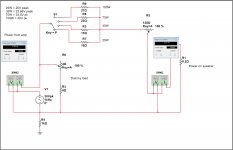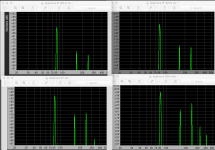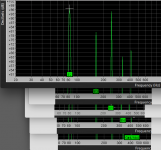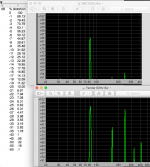I would be interested in building a passive device to plug in at the output of an audio amp, which will consume all the power coming in into a dummy load, and send some power into a set of speakers, adjustable via a volume knob.
For example at 10W output coming in from the audio amp, I'd send 5W into the dummy load and 5W to the speaker, at full volume (the device volume control, not the audio amp). If I turned the device's volume down to 2W (audio amp still at 10W), then I'd send 8W to the dummy load. So the device always consumes the full power coming in, but diverts from 0W to 5W to a set of speakers, via a volume control. Maximum volume should always be 5W, never more.
Is there a way to do this passively?
For example at 10W output coming in from the audio amp, I'd send 5W into the dummy load and 5W to the speaker, at full volume (the device volume control, not the audio amp). If I turned the device's volume down to 2W (audio amp still at 10W), then I'd send 8W to the dummy load. So the device always consumes the full power coming in, but diverts from 0W to 5W to a set of speakers, via a volume control. Maximum volume should always be 5W, never more.
Is there a way to do this passively?
Have a look at 100volt line speaker systems for an insight to how the PA world works.
For quality, use a 'Power soak" as they are called. A lot of bands use them to sink the power from large guitar amplifiers and send a lower signal to the speakers.
Guitar Amp Attenuators – Thomann UK
For quality, use a 'Power soak" as they are called. A lot of bands use them to sink the power from large guitar amplifiers and send a lower signal to the speakers.
Guitar Amp Attenuators – Thomann UK
Thanks for the links, I read about the high voltage speakers, all with their own transformers.
We already have the Mesa cabclone which my son finds the sound of very different to the real thing. It also does not have a volume control to the speaker, it's either on or off. I think it tries to be too clever, and by missing out on a pass-through volume control it becomes very inflexible, for all the £300 it costs.
In terms of electronic diagram, I have now come up with a simple design, totally resistive and passive. I am attempting to keep the load to the amp constant while diverting up to 5W to the "through" jack. I am hardcoding the loadbox at 8 Ohms. I have included a switch which allows the box to work with various guitar amps, from 25W to 100W.
Of course the load is purely resistive (most of it) and therefore we may not get to hear the amp's output stage's reaction to real speakers, however it is a good approximation and it simulates OK.
What do you think?
We already have the Mesa cabclone which my son finds the sound of very different to the real thing. It also does not have a volume control to the speaker, it's either on or off. I think it tries to be too clever, and by missing out on a pass-through volume control it becomes very inflexible, for all the £300 it costs.
In terms of electronic diagram, I have now come up with a simple design, totally resistive and passive. I am attempting to keep the load to the amp constant while diverting up to 5W to the "through" jack. I am hardcoding the loadbox at 8 Ohms. I have included a switch which allows the box to work with various guitar amps, from 25W to 100W.
Of course the load is purely resistive (most of it) and therefore we may not get to hear the amp's output stage's reaction to real speakers, however it is a good approximation and it simulates OK.
What do you think?
Attachments
I think the simplest way to accomplish what you want to do would be to use a 100 watt "L-Pad" attenuator.We already have the Mesa cabclone which my son finds the sound of very different to the real thing.
What do you think?
However, reducing the power (voltage) to the speaker will still not sound the same as the "real thing", because the speaker's excursion will no longer be driven past it's linear range of operation, above "Xmax". By current definition, Xmax is the one way excursion above which the "linearity" of the motor deviates by 10%, also resulting in 10% distortion at Fs (the driver's free air resonant frequency) in free air.
Above Xmax, loudspeakers generate even and odd order harmonics, that distortion, as much (or more) than amplifier distortion defines the sound and "overdrive" character of an amp/speaker combination, which can easily exceed 100%- harmonics at higher levels than the fundamental tones.
Guitar speakers generally have small Xmax, using short voice coils easily driven out of their short magnetic gaps, so produce far more distortion at lower drive levels than speakers designed for "hi-fi", clean sound reproduction.
To sound half as loud at 1kHz requires a reduction of 10 dB, 10 watts dropped to 1 watt. Reducing power by 6 dB halves excursion- a speaker designed to be driven well into distortion at 10 watts may hardly distort at all with 2.5 watts, a 6 dB drop in power. Although a guitar speaker may have only 1/4 the Xmax of a speaker designed for clean sound reproduction, the lightweight cone and coil generally result in much higher sensitivities.
Smaller drivers are less sensitive, which can be used to advantage when distortion is a desired feature, as in electric guitar amplification. A 6" guitar speaker is around 6 dB less sensitive than a 12", so would also start to distort with about 6 dB less sound pressure level than the 12", the equivalent of dropping the 12" from 10 watts to 2.5 watts, but still maintaining the amp/speaker distortion with no attenuation.
Of course, even with a small speaker with the same distortion signature as a larger one at higher SPL (sound pressure level), having less SPL lessens sustain (acoustic-electric feedback). If SPL is dropped 6 dB one must move the guitar twice as close to the speaker for the same "feel".
Art
Last edited:
Actually, regarding the above schematic, I just checked, and I would need lots of watts for the pots, the first one at 25W for a 100W amp, or 9W for a 35W amp. There are very expensive rheostats of such power but maybe there is another design to do this with inexpensive parts.
I think the simplest way to accomplish what you want to do would be to use a 100 watt "L-Pad" attenuator.
However, reducing the power (voltage) to the speaker will still not sound the same as the "real thing", because the speaker's excursion will no longer be driven past it's linear range of operation, above "Xmax". By current definition, Xmax is the one way excursion above which the "linearity" of the motor deviates by 10%, also resulting in 10% distortion at Fs (the driver's free air resonant frequency) in free air.
Above Xmax, loudspeakers generate even and odd order harmonics, that distortion, as much (or more) than amplifier distortion defines the sound and "overdrive" character of an amp/speaker combination, which can easily exceed 100%- harmonics at higher levels than the fundamental tones.
Guitar speakers generally have small Xmax, using short voice coils easily driven out of their short magnetic gaps, so produce far more distortion at lower drive levels than speakers designed for "hi-fi", clean sound reproduction.
To sound half as loud at 1kHz requires a reduction of 10 dB, 10 watts dropped to 1 watt. Reducing power by 6 dB halves excursion- a speaker designed to be driven well into distortion at 10 watts may hardly distort at all with 2.5 watts, a 6 dB drop in power. Although a guitar speaker may have only 1/4 the Xmax of a speaker designed for clean sound reproduction, the lightweight cone and coil generally result in much higher sensitivities.
Smaller drivers are less sensitive, which can be used to advantage when distortion is a desired feature, as in electric guitar amplification. A 6" guitar speaker is around 6 dB less sensitive than a 12", so would also start to distort with about 6 dB less sound pressure level than the 12", the equivalent of dropping the 12" from 10 watts to 2.5 watts, but still maintaining the amp/speaker distortion with no attenuation.
Of course, even with a small speaker with the same distortion signature as a larger one at higher SPL (sound pressure level), having less SPL lessens sustain (acoustic-electric feedback). If SPL is dropped 6 dB one must move the guitar twice as close to the speaker for the same "feel".
Art
Great stuff, thank you.
When the output stage is overdriven, even on dummy load, you can clearly see it on the scope, and this is (a large) part of the shaping that gets missed when we play quietly. It is part of the "valve" sound, and it is also how the sound gets shaped in the preamp sections. We will miss out on other parts of the overall sound shaping, reactivity of speakers, cab, output transformers, and overdriven speakers - all this for being able to play quietly (1-2 Watts max).
When the output stage is overdriven, even on dummy load, you can clearly see it on the scope, and this is (a large) part of the shaping that gets missed when we play quietly. .. We will miss out on other parts of the overall sound shaping, reactivity of speakers, cab, output transformers, and overdriven speakers - all this for being able to play quietly (1-2 Watts max).
Akis,
As you note, the “valve” overdrive can be clearly seen, as can the overdrive of a guitar speaker.
1-2 watts may still be too loud for a small space, while not driving the speaker into distortion that is arguably contributes as much of the sound of electric guitar as the amplifier.
A typical 2x12” guitar cabinet plays at 103 to 108 dB at one meter with just one watt, 111 dB at two watts is hardly “quiet”, but still won’t come close to the distortion we associate with that type of cabinet driven with the usual 50-100 watt tube (valve) amp.
To illustrate the effect of overdriving a speaker, a sine wave tone at 82 Hz, the low E note on a guitar, was sent at various levels from 1 to 8 watts (a 9 dB range) to an Epiphone 8” speaker, standard issue in the Valve Jr. combo “5 watt” amp.
Measured at one meter, 1 watt, the second harmonic is about 22 dB down from the 89 dB fundamental, around 8% distortion. At 2 watts, up to around 11% distortion, still relatively “clean” for electric guitar. At 4 watts, the third harmonic now has risen above the second, more “edge”, though THD is still under 14%. At 8 watts, the distortion almost triples to over 28%, with upper third, fourth and fifth harmonics rising. About twice as “loud” sounding (+9dB) but tripling the distortion increases the perceived loudness considerably over what the the SPL (Sound pressure level) alone would indicate.
The 8” speaker used in the Fender VibroChamp XD, also a tube combo “5 watt” amp, has nearly 100% THD driven at 8 watts, the third harmonic only 2 dB down from the 82 Hz fundamental. Of interest, the resulting distortion from that drive level creates a full “E major” chord from the single E (82 Hz sine wave) tone- E, B and G# notes appear in the harmonic sequence.
8 watts into a B&C 8” designed for high power PA midrange use shows little distortion, the third harmonic around 29 dB below the fundamental, about 3.55% distortion.
Guitar speakers designed for higher power amps won’t have enough distortion when played at a only a few watts, I’d suggest trying small guitar speakers for volume reduction in addition to amplifier attenuation if you’d like to satisfy the search for electric guitar “tone” at “quiet” levels.
Art
Attachments
Last edited:
What is the purpose of this device? Maybe my experience is limited, but I can't think of any good reason to create such an unorthodox circuit at home.
Why not control the maximum input to the amp with a single low power resistor and a pot?
B.
Why not control the maximum input to the amp with a single low power resistor and a pot?
B.
Ben,1)What is the purpose of this device?
2)Maybe my experience is limited, but I can't think of any good reason to create such an unorthodox circuit at home.
3)Why not control the maximum input to the amp with a single low power resistor and a pot?
1) The purpose of a load resistor for a guitar amp is to be able to run the amplifier into distortion while reducing the sound pressure level, and still maintain a suitable load impedance for the amplifier.
2) Nothing too "unorthodox" about protecting hearing- at home, a guitar amplifier designed for "filling" a large room and keeping up with loud drums and horns may be too loud when run at the level needed for it to contribute the distortion inherent when run at usual rock concert levels.
3) That would eliminate the harmonic distortion of the tube input and output stages that are desired for electric guitar, as well as the signal compression achieved when amplifier and speaker limits are approached.
As you once wrote:
"Depending on the assortment of harmonics and other sounds, an instrument may seem kind of shrill (like reed stops on an organ) or kind of mellow (like flue stops on an organ)."
Amplifier distortion, speaker distortion and other effects used with "electric" musical instruments can be shaped to respond to dynamic playing input, enabling a wider range of harmonic diversity than possible with a single acoustic instrument.
Art
Thank you, Art. How stupid of me to not realize some folks want distortion, as with electric guitars.
But really, the distortion from over-run and under-feedback tubes is a total accident of tube design. Nothing musical about it in the sense that it bears no relation to the music, rhythm/beat excepted.
Now it is true that nobody would be so ill-informed as to want my opinion on this topic, but if I had any delight in distorted guitar sounds, I'd make circuits that created types of distortion that seemed desirable for aesthetic reasons, not that were simply an accident of the layout of the grids in the 6L6/EL34 tube design of 1940.
Which gives me an opportunity to mention my friend at Bell Labs, Max Neuhaus, once a famous percussionist, a few doors from my office. He produced commercial releases (on Columbia?) using "music" arising from contact mikes on speaker cabs. (Perhaps this belongs in that other thread going strong elsewhere about wall vibration.) Disgusting sound, to my ears. If the carpenter put a wall brace in another spot, you'd get different wall vibration. Same thing with tubes.
BTW, there are organs that dobsound awful although I suspect all the basic instruments never do, bag-pipes excepted.
B.
But really, the distortion from over-run and under-feedback tubes is a total accident of tube design. Nothing musical about it in the sense that it bears no relation to the music, rhythm/beat excepted.
Now it is true that nobody would be so ill-informed as to want my opinion on this topic, but if I had any delight in distorted guitar sounds, I'd make circuits that created types of distortion that seemed desirable for aesthetic reasons, not that were simply an accident of the layout of the grids in the 6L6/EL34 tube design of 1940.
Which gives me an opportunity to mention my friend at Bell Labs, Max Neuhaus, once a famous percussionist, a few doors from my office. He produced commercial releases (on Columbia?) using "music" arising from contact mikes on speaker cabs. (Perhaps this belongs in that other thread going strong elsewhere about wall vibration.) Disgusting sound, to my ears. If the carpenter put a wall brace in another spot, you'd get different wall vibration. Same thing with tubes.
BTW, there are organs that dobsound awful although I suspect all the basic instruments never do, bag-pipes excepted.
B.
Last edited:
Ben,But really, the distortion from over-run and under-feedback tubes is a total accident of tube design. Nothing musical about it in the sense that it bears no relation to the music, rhythm/beat excepted.
BTW, there are organs that dobsound awful although I suspect all the basic instruments never do, bag-pipes excepted.
You are certainly entitled to your opinion of bagpipes and certain instruments as sounding "awful".
The "total accident of tube design" and overdriven speakers has played an important part in music as long as they have been around, and their distortion is harmonically very related to music, just as are the variety of tonal drawbar stops available from the now-classic tone wheel organs originating from a similar age in time.
As evidenced by the millions of musicians and billions of people that like that type of distortion in the music they listen to and support, it won't be going away. Those types of musical sounds have been around for well over a century, starting with the Telharmonium, created in 1897.
In any electro-magnetic musical instrument, the choice of speakers used is an important part of the design. A Hammond B-3 without a Leslie speaker, or played "flat" through a "high fidelity" speaker can sound more like a bad set of bagpipes than the church, jazz and rock sounds we usually associate it with.
As I recall, you use Mac computers, you might try playing with the speaker/amp emulations available in the Garage Band program to expand your understanding of haw distortion can be used for enhancing a signal.
Art
Art - if you re-read my post, you'll see I don't pre-judge how a sound originates or is modified. BTW, I probably like bagpipe music (from many countries around the globe) better than the popular opinion. Moreover, I enjoy music from everywhere and all periods and instruments and attend concerts of the same. (Went to a great Partch concert in the Disney Hall. See Harry Partch in Wiki)
My point is that musicians should have a choice about how to shape their sounds. Simply opting to play whatever happens to be coincidentally coming out of a tube by virtue of how a mechanical engineer chose to lay out the grids inside the tube - that just isn't a musical judgment. Granted, there can be some bit of choice within the scope available of choosing triodes over pentodes or vice versa. But the musician is simply passive.
B.
My point is that musicians should have a choice about how to shape their sounds. Simply opting to play whatever happens to be coincidentally coming out of a tube by virtue of how a mechanical engineer chose to lay out the grids inside the tube - that just isn't a musical judgment. Granted, there can be some bit of choice within the scope available of choosing triodes over pentodes or vice versa. But the musician is simply passive.
B.
My point is that musicians should have a choice about how to shape their sounds. Simply opting to play whatever happens to be coincidentally coming out of a tube by virtue of how a mechanical engineer chose to lay out the grids inside the tube - that just isn't a musical judgment.
Perhaps for the very first guitarists to use the very first electric guitar amps that might have been true, but for every guitarist since then, they absolutely have had a choice, and they continue to make that choice all the time.
Perhaps for the very first guitarists to use the very first electric guitar amps that might have been true, but for every guitarist since then, they absolutely have had a choice, and they continue to make that choice all the time.
That's like saying aboriginal tribes have a choice in what shoes to wear.
Yes, musicians have a great many choices - esp with Garage Band or stand-alone synthesizers - including "classical" music makers. And tone/tuning/scale/rhythm choices.
But choosing which brand of tube amp to overdrive seems like a flat-earth approach for technical know-nothings who wouldn't know a fuzz-box from a germanium diode*. Like trying to decide if oak or mahogany is more comfortable for your shoe soles.
B.
* some folks may know that's a trick question
Hi Allen, I am thinking an AC power variac wired as standard auto transformer like below but I don't know what the frequency response/sound would be like....maybe trendsetting lol.Just came across this. Max, did you mean a common variac or a line-level, dual-gang autotransformer?.
The switchable shunt resistors are to keep control of overall impedance, an extra permanent shunt resistor directly across the variac would be wise and I am not sure about the series value.
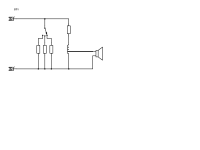
Or maybe something like this might work ?.....

Dan.
"was sent at various levels from 1 to 8 watts (a 9 dB range) to an Epiphone 8” speaker, standard issue in the Valve Jr. combo “5 watt” amp."
What was the wattage of that speaker? Our speakers are 75W (stonehenge), 150W (tonkers) etc
What was the wattage of that speaker? Our speakers are 75W (stonehenge), 150W (tonkers) etc
My variac is 500VA so can handle loads above 100 ohms, I don't think the lows are going to be a problem. I'd be interested to measure the self-resonance though.I don't know what the frequency response/sound would be like....
I guess we aren't talking Voltage sources here.The switchable shunt resistors are to keep control of overall impedance,
What about derating the transformer for low voltage input?
What's it there for?and I am not sure about the series value.
Interesting. There may be some signal flux cancellation.Or maybe something like this might work ?.....
Last edited:
I'm talking tube amp transformer output so it needs some minimum value of resistance as load.I guess we aren't talking Voltage sources here.
500VA is way past what's needed.What about derating the transformer for low voltage input?
Attenuation and reduction of inductive component of load.What's it there for?
I didn't think it through or simulate, just a suggestion ?.Interesting. There may be some signal flux cancellation.
Dan.
Last edited:
- Home
- Loudspeakers
- Multi-Way
- Audio power distribution box
